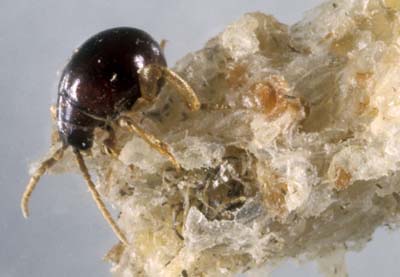
Adult Gibbium aequinoctiale, a spider beetle.
(Photographer: L.J. Buss, University of Florida)
Spider beetles are found throughout the world, especially in colder regions where they may remain active even in freezing temperatures. They are minor pests of stored products and are usually an indication of poor sanitation. They feed on both plant and animal materials, such as broken grain, grain products, seeds, dried fruit and meats, fish meal, wool, hair, rodent droppings, etc. As a result, the source of infestation may be difficult to locate. About 50 species of spider beetles are found in the U.S. and Canada, but only about 13 species are considered to be pests.
Adult spider beetles range from 1 to 5 mm in length. Their bodies appear spider-like and are usually oval, or sometimes globular or elongate. Their legs and antennae are usually long, thin and covered with hairs. In some species, male and females appear quite different. In color, they range from a pale, brownish yellow to reddish brown to almost black; other species are bicolored. The head is usually concealed from above and the antennae are threadlike, with the bases of the antennae close together. The prothorax is narrower than the elytra (wing covers). Some species can fly. Females may lay up to a 100 eggs, but most species lay fewer, on or near the larval food The larvae range from 3 to 5 mm in length and are dirty white in color. They have three pairs of well-developed thoracic legs. Development time from egg to adult ranges considerably, depending upon the species, from less than two weeks to over three months.
Images
To save the Web-optimized images shown below to your hard drive:
|
Click to access Display and Print quality images. |
|
Click to access Display and Print quality images. |